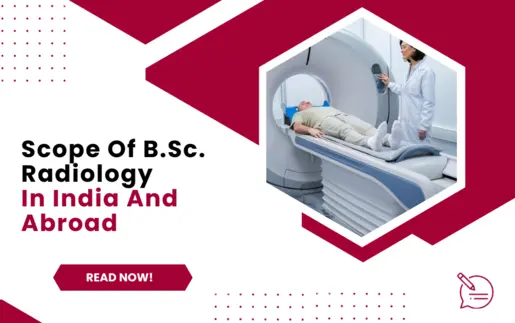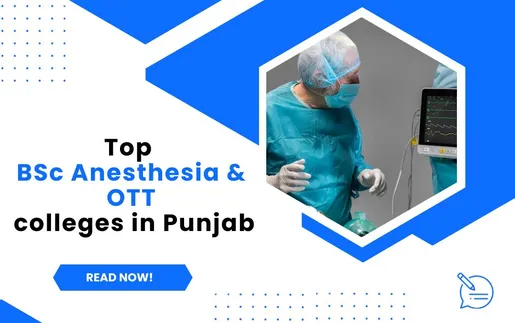B. Optometry vs B.Sc. Radiology & Imaging Technology: A Breakdown of Two Thriving Careers
Are you fascinated by the intricacies of the human body and drawn to a career in healthcare? If so, consider either B. Optometry vs B.Sc. Radiology & Imaging Technology. Both offer exciting paths to advantageous careers where you can significantly impact people's lives. This breakdown will delve into optometry and radiology, helping you decide which exciting field best aligns with your interests and goals.
What is B. Optometry?
B. Optometry stands for Bachelor of Optometry. It is a four-year undergraduate program that prepares students for a career as an optometrist. Optometrists are primary eye care professionals who diagnose and treat various vision problems and conditions. They can prescribe corrective lenses, such as eyeglasses and contact lenses, and medication to treat certain eye diseases.
B. Optometry Course Highlights
|
Feature |
B. Optometry |
|
Course Name |
Bachelor of Optometry |
|
Course Duration |
Four years |
|
Focus |
Primary eye care |
|
Coursework |
- Anatomy & physiology of the eye - Optics & vision science - Pharmacology of the eye - Pathology of the eye - Primary eye care - Clinical procedures |
|
Skill Development |
- Vision assessment - Contact lens fitting - Eye disease diagnosis & treatment - Patient communication - Clinical skills |
|
Career Paths |
- Private practice optometrist - Clinical optometrist (hospitals/clinics) - Research optometrist - Pediatric optometrist - Geriatric optometrist |
|
Eligibility |
12th standard (Science) with good marks in Physics, Chemistry, Biology |
|
Subjects (indicative) |
- Ocular Anatomy - Physiological Optics - Binocular Vision - Optometric Pharmacology - Contact Lens Fitting |
|
Fees (INR) (Indicative) |
Varies (generally between ?50,000 - ?3,00,000 per year) |
|
Selection Process |
Entrance exams & merit-based |
What is B.Sc. Radiology & Imaging Technology?
A B.Sc. Radiology & Imaging Technology equips you to be an imaging detective in medicine in three years. Through coursework in X-ray, ultrasound, CT scans, and MRIs, you'll master operating the machines, understand how the images are created, and even analyze them to aid doctors in diagnosing patients. You'll also become an expert on radiation safety and patient care, ensuring a smooth and safe experience for everyone involved.
B.Sc. Radiology & Imaging Technology Course Highlights
|
Feature |
B.Sc. Radiology & Imaging Technology |
|
Course Name |
Bachelor of Science in Radiology & Imaging Technology |
|
Course Duration |
Three years |
|
Focus |
Diagnostic imaging techniques |
|
Coursework |
- Radiography & imaging techniques - Medical imaging equipment - Image processing & reconstruction - Radiation safety - Patient care in radiology |
|
Skill Development |
- X-ray operation - Operating imaging equipment - Image analysis - Patient positioning - Adherence to radiation safety protocols |
|
Career Paths |
- Diagnostic radiographer - X-ray technician - Ultrasound technician - MRI technician - Radiation therapy technician |
|
Eligibility |
12th standard (Science) with minimum marks (varies) |
|
Subjects (indicative) |
- Radiographic Anatomy & Physiology - Radiographic Techniques - Medical Imaging Physics - Radiation Protection & Safety |
|
Fees (INR) (Indicative) |
Varies (generally between ?30,000 - ?70,000 per year) |
|
Selection Process |
Merit-based or entrance exams (varies) |
Difference Between B. Optometry vs B.Sc. Radiology & Imaging Technology
Here's a breakdown of the key differences between a B. Optometry vs B.Sc. in Radiology & Imaging Technology:
Field of Focus
B. Optometry: Deals with the health and care of the eyes. Optometrists diagnose and treat vision problems, prescribe corrective lenses, and manage eye diseases.
B.Sc. Radiology & Imaging Technology: Focuses on medical imaging techniques to diagnose diseases. This involves operating X-ray machines, CT scanners, and other imaging equipment to produce internal body images for doctors to analyze.
Coursework
B. Optometry: This program includes an in-depth study of the eye, vision science, optics, pharmacology, and ocular diseases. Students gain experience performing eye examinations, using diagnostic equipment, and fitting corrective lenses.
B.Sc. Radiology & Imaging Technology: Courses cover human anatomy, physiology, radiation physics, radiographic techniques, and patient care. Students get hands-on training in operating imaging equipment, following safety protocols, and positioning patients for X-rays and other scans.
Career Path
B. Optometry: Graduates become Optometrists who can work in private practice, retail optical shops, hospitals, or clinics. They provide primary eye care, prescribe corrective lenses, and diagnose and treat some eye diseases. Some optometrists pursue further education to specialize in pediatric optometry or low-vision rehabilitation.
B.Sc. Radiology & Imaging Technology: After graduation, you can become a Radiologic Technologist or X-ray technician. They operate imaging equipment to produce diagnostic images radiologists use for disease detection. You can specialize in X-rays, CT scans, MRI, or nuclear medicine technology.
B. Optometry Syllabus vs B.Sc. Radiology & Imaging Technology Syllabus
The syllabuses for B. Optometry vs B.Sc. Radiology & Imaging Technology differ significantly as they prepare students for distinct healthcare roles. Here's a general comparison:
B. Optometry Syllabus
Focus: Anatomy and physiology of the eye, optics, vision science, ocular pathology, pharmacology for the eye.
Curriculum
- Ocular Anatomy & Physiology
- Geometric & Physical Optics
- Principles of Refraction & Optometric Procedures
- Binocular Vision & Ocular Motility
- Ocular Pharmacology & Therapeutics
- Dispensing Optics (contact lenses, eyeglasses)
- Pediatric Optometry or Geriatric Optometry (depending on specialization)
B.Sc. Radiology & Imaging Technology Syllabus
Focus: Human anatomy and physiology, radiation physics, radiographic techniques, patient care, medical imaging equipment.
Curriculum
- Human Anatomy & Physiology
- Radiation Physics & Protection
- X-ray Techniques & Film Processing
- CT Scan Technology & Procedures
- Magnetic Resonance Imaging (MRI) Principles
- Fluoroscopy & Special Imaging Procedures
- Patient Positioning & Radiation Safety Protocols
Both B. Optometry vs B.Sc. Radiology & Imaging Technology offers exciting career paths in healthcare at CGC Jhanjeri. However, the ideal choice depends on your interests and goals. If your passion lies in vision care and working directly with patients to improve their sight, then B. Optometry might be the perfect fit. On the other hand, if you're fascinated by medical technology and playing a crucial role behind the scenes in diagnosing diseases, B.Sc. Radiology & Imaging Technology could be the better option.
Ultimately, the decision comes down to your personal preferences. Consider your strengths – are you detail-oriented and enjoy working with intricate equipment (Radiology), or do you have a knack for patient interaction and explaining complex medical concepts (Optometry)?
Contact the CGC Jhanjeri admissions department or faculty advisors to learn more about each program's curriculum, career prospects, and potential specializations. With their expert guidance and support, you can make a well-informed decision and embark on a rewarding journey in the healthcare field at CGC Jhanjeri, feeling confident about your choice.
Frequently Asked Questions
Q. Which is better, Optometry or Radiology?
A. There's no single "better" option. Optometry focuses on primary eye care, prescribing glasses and contacts, while Radiology uses imaging technology to aid diagnoses across various medical fields. Consider your interests: Do you prefer direct patient interaction (Optometry) or working behind the scenes with technology (Radiology)?
Q. Which is better, B.Optometry or B.Sc. Optometry?
A. In most cases, B.Optometry and B.Sc. Optometry leads to the same qualifications for practicing optometry. However, some universities might offer slight curriculum or program structure variations—research individual programs for specifics.
Q. What is the scope of B.Sc. Radiology and Imaging Technology?
A. This field offers diverse opportunities in hospitals, clinics, and research institutions. Graduates can work as radiographers, performing X-rays, CT scans, or MRIs. Specialization paths like sonography or nuclear medicine are also available.
Q. What is the highest package of B. Optometry?
A. Salaries vary depending on experience, location, and practice setting. Entry-level optometrists might start around a specific range, with potential for growth over time—research average salaries in your desired area for a more accurate idea.
Q. Is B. Optometry called Doctor?
A. No. Optometrists are not medical doctors (MDs). They hold a Doctor of Optometry (OD) degree focused on vision care.
Q. Can I open my clinic after I earn my B? Optometry?
A. Optometrists can establish private practices after completing their education and obtaining relevant licenses.
Q. Can I use Dr. after Optometry?
A. While OD stands for Doctor of Optometry, the appropriate title is "Optometrist" to avoid confusion with medical doctors.
Q. Can I get a Ph.D. after earning a B. Optometry?
A. You can pursue a Ph.D. in vision science or a related field after your B. Optometry degree. This path focuses on research and academia.
Q. Does Optometry require NEET?
A. NEET (National Eligibility Entrance Test) is typically required for medical programs like MBBS in India. Optometry entrance exams might differ. Research specific program requirements for the universities you're interested in.
Q. Can I do MD after B. Optometry?
A. An MD (Doctor of Medicine) is a postgraduate degree for medical doctors (MBBS). B. Optometry prepares you for a Doctor of Optometry (OD) degree specializing in vision care.




















